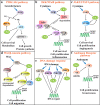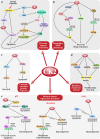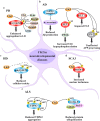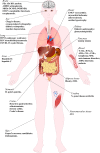Protein kinase CK2: a potential therapeutic target for diverse human diseases
- PMID: 33994545
- PMCID: PMC8126563
- DOI: 10.1038/s41392-021-00567-7
Protein kinase CK2: a potential therapeutic target for diverse human diseases
Abstract
CK2 is a constitutively active Ser/Thr protein kinase, which phosphorylates hundreds of substrates, controls several signaling pathways, and is implicated in a plethora of human diseases. Its best documented role is in cancer, where it regulates practically all malignant hallmarks. Other well-known functions of CK2 are in human infections; in particular, several viruses exploit host cell CK2 for their life cycle. Very recently, also SARS-CoV-2, the virus responsible for the COVID-19 pandemic, has been found to enhance CK2 activity and to induce the phosphorylation of several CK2 substrates (either viral and host proteins). CK2 is also considered an emerging target for neurological diseases, inflammation and autoimmune disorders, diverse ophthalmic pathologies, diabetes, and obesity. In addition, CK2 activity has been associated with cardiovascular diseases, as cardiac ischemia-reperfusion injury, atherosclerosis, and cardiac hypertrophy. The hypothesis of considering CK2 inhibition for cystic fibrosis therapies has been also entertained for many years. Moreover, psychiatric disorders and syndromes due to CK2 mutations have been recently identified. On these bases, CK2 is emerging as an increasingly attractive target in various fields of human medicine, with the advantage that several very specific and effective inhibitors are already available. Here, we review the literature on CK2 implication in different human pathologies and evaluate its potential as a pharmacological target in the light of the most recent findings.
Conflict of interest statement
The authors declare no competing interests.
Figures




Similar articles
-
Protein kinase CK2 inhibition as a pharmacological strategy.Adv Protein Chem Struct Biol. 2021;124:23-46. doi: 10.1016/bs.apcsb.2020.09.003. Epub 2021 Jan 9. Adv Protein Chem Struct Biol. 2021. PMID: 33632467 Review.
-
Therapeutic targeting of CK2 in acute and chronic leukemias.Leukemia. 2018 Jan;32(1):1-10. doi: 10.1038/leu.2017.301. Epub 2017 Sep 27. Leukemia. 2018. PMID: 28951560 Free PMC article. Review.
-
Protein kinase CK2, cystic fibrosis transmembrane conductance regulator, and the deltaF508 mutation: F508 deletion disrupts a kinase-binding site.J Biol Chem. 2007 Apr 6;282(14):10804-13. doi: 10.1074/jbc.M610956200. Epub 2007 Feb 8. J Biol Chem. 2007. Retraction in: J Biol Chem. 2008 Sep 5;283(36):25103. PMID: 17289674 Retracted.
-
Addiction to protein kinase CK2: a common denominator of diverse cancer cells?Biochim Biophys Acta. 2010 Mar;1804(3):499-504. doi: 10.1016/j.bbapap.2009.07.018. Epub 2009 Aug 6. Biochim Biophys Acta. 2010. PMID: 19665589 Review.
-
Cross-talk between the CK2 and AKT signaling pathways in cancer.Adv Biol Regul. 2017 May;64:1-8. doi: 10.1016/j.jbior.2017.03.002. Epub 2017 Mar 28. Adv Biol Regul. 2017. PMID: 28373060 Review.
Cited by
-
Identification of novel proteins for coronary artery disease by integrating GWAS data and human plasma proteomes.Heliyon. 2024 Sep 19;10(19):e38036. doi: 10.1016/j.heliyon.2024.e38036. eCollection 2024 Oct 15. Heliyon. 2024. PMID: 39386869 Free PMC article.
-
Analysis of the phosphoproteome of CK2α(-/-)/Δα' C2C12 myoblasts compared to the wild-type cells.Open Biol. 2023 Feb;13(2):220220. doi: 10.1098/rsob.220220. Epub 2023 Feb 22. Open Biol. 2023. PMID: 36809799 Free PMC article.
-
Emerging role of Protein Kinase CK2 in Tumor immunity.Front Oncol. 2022 Dec 1;12:1065027. doi: 10.3389/fonc.2022.1065027. eCollection 2022. Front Oncol. 2022. PMID: 36530985 Free PMC article. Review.
-
Haploinsufficiency as a Foreground Pathomechanism of Poirer-Bienvenu Syndrome and Novel Insights Underlying the Phenotypic Continuum of CSNK2B-Associated Disorders.Genes (Basel). 2023 Jan 18;14(2):250. doi: 10.3390/genes14020250. Genes (Basel). 2023. PMID: 36833176 Free PMC article.
-
Editorial: Pharmacological and Biochemical Perspectives of Kinase Inhibitors in Cancer and COVID-19 Therapeutics, Volume I.Front Pharmacol. 2022 Jun 15;13:916324. doi: 10.3389/fphar.2022.916324. eCollection 2022. Front Pharmacol. 2022. PMID: 35784709 Free PMC article. No abstract available.
References
Publication types
MeSH terms
Substances
Grants and funding
- IG 18756/Associazione Italiana per la Ricerca sul Cancro (Italian Association for Cancer Research)
- 22974/AFM-Téléthon (French Muscular Dystrophy Association)
- FFC#12/2017/Fondazione per la Ricerca sulla Fibrosi Cistica (Fondazione FFC)
- FFC#11/2019/Fondazione per la Ricerca sulla Fibrosi Cistica (Fondazione FFC)
LinkOut - more resources
Full Text Sources
Other Literature Sources
Medical
Miscellaneous

